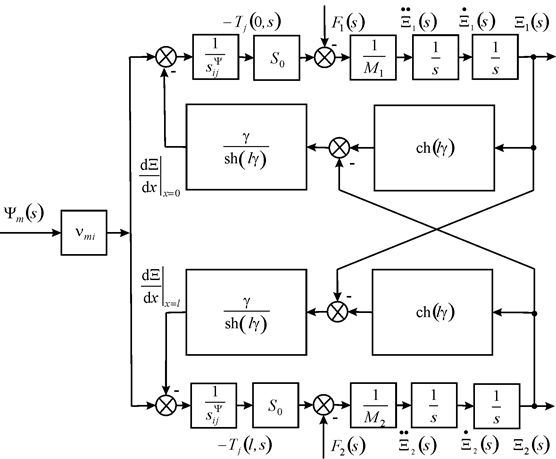The equations27–35 of the piezoeffects have form
where
are matrixes of electric induction, piezomodule, strength mechanical field, dielectric constant, strength electric field, relative displacement, elastic compliance, transposed piezomodule. The matrixes coefficients we have for a PZT piezoactuator.36–52
The equation of the mechanical characteristic is written for a piezoactuator
where
for
and
for
,
is the length,
is the area of a piezoactuator.
For the longitudinal piezoactuator the relative displacement8–21 is written
where
is the longitudinal piezomodule.
In the mechanical characteristic of the longitudinal piezoactuator for astrophysics the maximums values of the displacement
and the force
are determined
At
= 1.5∙105 V/m,
= 4∙10-10 m/V,
= 1.5∙10-4 m2,
= 2.5∙10-3 m,
= 15∙10-12 m2/N for the longitudinal piezoactuator are obtained
= 150 nm,
= 600 N with error 10%.
Therefore, for the mechanical characteristic of the transverse piezoactuator we have its maximums values
At
= 2.4×105 V/m,
= 2∙10-10 m/V,
= 1∙10-2 m,
=0.5∙10-3 m,
= 1∙10-5 m2,
= 12∙10-12 m2/N the parameters are received
= 480 nm,
= 40 N.
The differential equation of a piezoactuator12–52 is written
here
are the Laplace transform of the displacement, the parameter, the coordinate and the propagation factor.
The nanodisplacements are obtained for the longitudinal piezoactuator
for
for
The decision of the differential equation is determined
Taking into account the boundary conditions for two faces, we obtain the system of the equations for the structural model of the longitudinal piezoactuator
where
are the Laplace transforms of the displacements for two faces.
We have the system of the equations for the structural model of the transverse piezoactuator
Therefore, we have the system of the equations for the structural model of the shift piezoactuator in the form
The system of the equations for the structural model of a piezoactuator is determined for Figure 1
where
The structural scheme on Figure 1 is used for the decision of a piezoactuator in astrophysics. The matrix of the nanodisplacement of a piezoactuator has the form.

Figure 1 Structural scheme of piezoactuator.
The steady-state nanodisplacements are written for two faces of a piezoactuator
The steady-state nanodisplacements are obtained for two faces of the longitudinal piezoactuator
At U = 75 V,
= 1 kg,
= 4 kg,
= 4×10-10 m/V the steady-state nanodisplacements are determined
= 24 nm,
= 6 nm and
= 30 nm with error 10%.
The transfer equation of the transverse piezoactuator is determined at one the fixed face and the elastic-inertial load
where
is the transfer coefficient,
,
are the stiffness for the load and the transverse piezoactuator,
are the time constant, the attenuation coefficient, the conjugate frequency.
At
= 0.2×107 N/m,
= 1.4×107 N/m,
= 2 kg the parameters are obtained
= 0.354×10-3 s,
= 2.8×103 s-1 with error 10%.
The steady-state nanodisplacement of the transverse piezoactuator is written for elastic-inertial load
At
= 20,
= 0.14,
= 2∙10-10 m/V the transfer coefficient of the transverse piezoactuator is received
= 3.5 nm/V with error 10%.


